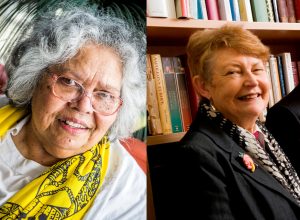The nee d for recognising past injustices towards Indigenous Australians was a powerful topic at this year’s International Association for Genocide Scholars (IAGS) conference in Brisbane.
d for recognising past injustices towards Indigenous Australians was a powerful topic at this year’s International Association for Genocide Scholars (IAGS) conference in Brisbane.
The 2017 conference saw several global scholars come together at the University of Queensland’s St Lucia campus for a collective discussion about the two core components of the UN Convention: justice for acts of genocide, and prevention of future genocides.
Indigenous Australian academic and activist Lilla Watson, opened the conference on Sunday night with an insightful keynote on the widespread effects of colonialism and intergenerational trauma.
“The events of colonialism have severely disrupted the lives of Aboriginal Australians, and this is evidenced by high suicide rates, poor social and physical wellbeing, incarceration rates, among many other issues which pervade Australia’s Indigenous communities,” Ms Watson said.
According to Watson, governmental policies still fail to recognise the importance of land for Australia’s Indigenous people and ultimately exemplify a Western bias towards the fundamentals of Indigenous culture.
“The foundation of original Australia and its complex structures have been fundamentally ignored by the Australian government. Western concepts of progress are inherently different to that of Indigenous concepts.
“A colonial mentality still controls the treatment and projection of policies towards Aborigines. This needs to be tackled with the formulation of bilateral agreements which will ensure the wellbeing of Australia’s aborigines.”
Historian and researcher at the University of Newcastle Professor Lyndall Ryan, also struck a chord with academics at this year’s conference, after she presented her groundbreaking research map which pinpoints the locations of past Indigenous massacres in Australia.
“The audience was fascinated by the information and arguments presented yesterday. One response was from a group of academics who had been researching massacres in Indonesia which occurred during the 70’s and 80’s, which was an incredibly violent time and a largely suppressed set of occurrences,” Prof Ryan said in an interview.
“They believe the map is an effective and simplistic medium in disseminating otherwise unknown and suppressed information.”
The online mapping project, which reveals the exact locations and details of 150 massacres which predominantly occurred along the Eastern Seaboard from 1788 to 1872, has seen an overwhelming response from both Indigenous and non-Indigenous Australians since its online release.
“Within the first 24 hours of the mapping being up, there was an avalanche response from both Aboriginal and non-Aboriginal people; ‘at last we’re going to see what happened.'”
The detailed massacres were part of the ‘Frontier Wars’ between Indigenous Australians and British settlers that lasted for many decades and saw thousands of Indigenous Australians murdered at the hands of British Imperialism.
However, according to Prof Ryan, the corroboration of massacre in Australia has a been difficult process, both due to the limited scope of evidence in historical texts and the national misconceptions surrounding the occurrence of massacres after British settlement.
“It has been a subject which has never been taken quite seriously, mainly due to the issue of evidence and that’s always paramount when it comes to finalising evidence or events.”
“Most historians have been trained to look for evidence which is as close to the event as possible. However, it’s almost the opposite case with massacres, because massacres are carried out in secret – the perpetrators don’t want you to know and they threaten the witnesses if they say anything.”
“In this case, the evidence lied in the information that came out later on, such as anecdotal evidence in addition to settler diaries and government archives.”
Prof Ryan is determined to broaden the map by including Western Australia and other states, and is hopeful the research will be implemented in school curriculums to increase the national understanding of the genocide.
The five-day conference saw survivors, academics, professionals, students, artists and members of the public engage in open debate and reflect on the global history of genocide, in a bid to prevent future acts of genocide.


